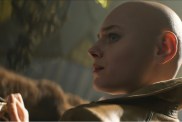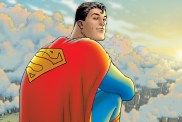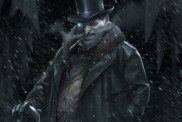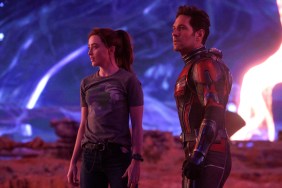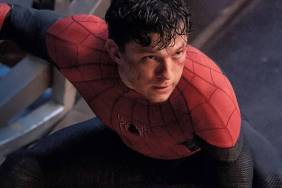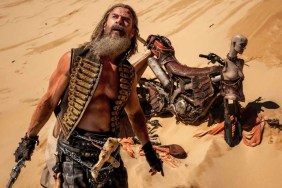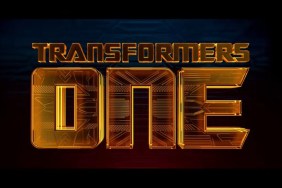
During our visit to the set of The Dark Knight in Chicago, we had the opportunity to interview co-writer/director Christopher Nolan. Before the interview, we were able to watch him filming a scene with Christian Bale and Gary Oldman. As the cast and crew took a break for lunch, Nolan joined us. Keep in mind that this was a long time before Heath Ledger’s untimely death, but even then his performance as Joker was a major topic of conversation. Also, please note that this interview was conducted next to a busy Chicago intersection, so some of the audio was unintelligible. If you see XXX’s below, that’s why.
CS/SHH!: What can you tell us about the scene we were just watching?
Nolan: Gosh, we should have finished it before lunch and didn’t. What can I tell you about that… it’s the first scene between Batman and Gordon in the film and it does a lot of stage setting, scene setting for talking about the time that has past between the first film and this film.
CS/SHH!: My five year old wants for see this film really badly. Is Heath Ledger going to scare the crap out of him and he’s going to have to have years of therapy?
Nolan: Yes, definitely. I wouldn’t take a five year old. I’d wait a few years.
CS/SHH!: Can you talk about Heath’s performance?
Nolan: What Heath’s doing is very unique and really I think pretty amazing and very frightening as the character should be. There’s a wicked sense of humor to it but he’s extremely entertaining but he’s definitely taking it in a very intense, very scary direction.
CS/SHH!: The name Johnny Rockstar XXX in regards to the Joker XXX.
Nolan: Well, we very much took the view in looking at the character of Joker that he, what’s strong about him is this idea of anarchy… this commitment to anarchy, this commitment to chaos. So he’s not just a bank robber or an ordinary criminal who’s out for material gain. His chief motivation would be that of anarchist. I talked to Heath a lot about it, even as we were writing the script, finishing the script, I should say, and we both agreed that, to me, that’s the most threatening force really in a way. That society bases that pure anarchy, someone who wants do harm really for it’s own sake and his own entertainment.
CS/SHH!: XXX
Nolan: Well let’s say that he’s the type of individual that attracts a certain type of individual to him and is able to recruit a certain type of individual to him.
CS/SHH!: In Lindy Hemming’s discussion of the Joker costume, she said she was looking for a reason why he would dress this way and initially came to the conclusion that’s just who he is…. he would. I interpret missing parts though. In this film the Joker’s in the house with an ABC reason, how he got wherever he was. How he got to be the Joker, he just is. Is that an accurate…
Nolan: That is and that’s the way of the comics too. If you read the first couple of appearances he just is and I think that’s absolutely why we wound up going that direction. Because we wanted to… we set out… we had set out to do a more realistic version of a character that’s been done before. So it fits into our somewhat more realistic, slightly grittier world view of the Batman universe. But ultimately you accept that the character just is that way. That becomes the most realistic way of doing it, rather than trying to find…we didn’t want to be trying to find real world explanations to every aspect of this character. What we realized is that to a certain extent the flamboyance of the character is who he is.
CS/SHH!: He’s a force of nature?
Nolan: Yeah he’s a force of nature and once you start thinking of the character as a given, as he just is who he is then the psychology of that becomes immediately very obvious and the idea that he’s a very usable character, a very anarchic character in our society to me starts to seem quite obvious.
CS/SHH!: What was it that made you want to revisit the world of Batman, what did you not say in the first film that you wanted to come back for?
Nolan: I think for me really, certainly addressing the character of the Joker has a lot to do with it. I mean overall I just very much enjoyed making the first film and I had no real intention of doing a sequel. But having created a view of Batman’s universe that then at the end of the film we introduced the idea or the thought of the Joker, that to me becomes an irresistible, creative process that myself, and David Goyer and Jonah have got into. It’s just a very interesting thing to sit around and think… okay, how does it work Batman without powers, how does that affect where we see Joker, who would that guy be in our universe.

CS/SHH!: What comic books did you refer to in fleshing out this iteration of the Joker? And the way he looks reminds me, quite a bit, of certain versions of the Joker written by Ed Brubaker, the facial scars…
Nolan: Well, to be honest myself and David Goyer just thought of, in our talking specifically about comics, he has an incredible knowledge about all the comic books, but we just really kind of dove in and tried to do our version of the character simply based on our memories of the comics. You know, without going back, and when Jonah came on board to write the first draft from our treatment, one of the things he specifically said was, “Did you look at the first appearances of the character?” And I said “No,” then we went back and looked at those as we were writing the script and we went up, I think, very, very close to the original jumping off point of the character in the history of the comics. In visual terms we really tried to just go our own way and work with Heath in developing what we thought would be the look of the character. Just in summary, basically it winds up being an amalgam, looking at everything that’s been done with the character. Just processing, just having the time, and fortunately we really did have the time, I was talking to David Goyer about that earlier before we started shooting. Just ruminating, just allowing our imaginations to remember what we remembered, and take what we took from the history of the comics and put it all together. Which is very much how we approached Batman in the first film.
CS/SHH!: What in your mind makes a good sequel? What pitfalls were you trying to avoid?
Nolan: I think that what makes a good sequel is a film that feels inevitable and that when you go back and see the first film you completely understand that the story had to continue with a second film. And I would be making this film have that feeling about a story and how that has to continue across. I think the pitfalls are simply repeating yourself, repeating yourself but on a bigger scale. And that’s something we’re not, I think we’re not doing that at all. We’re really very much creating a second half to the story.
CS/SHH!: Do you have any feeling about the inevitability of a third film?
Nolan: No, I’m really just making this film. Honestly, I’m sure I could look back and say at all the things I talked about when I was doing the first film because I wanted everything to be on the first film. That was a very genuine process, and for me having a great story of two halves is something really in accord with this movie. So when people see this movie they really feel that they have seen a complete story.
CS/SHH!: What did the actors think about coming back and reprising their roles?
Nolan: Well I think they’re all pretty excited I think, just about the nature of the material and where the story took them. And the great thing about doing a sequel that I didn’t really know until we dive into it is that you’ve set up all the characters, so you don’t have to take that time with the audience. So you can really take them to a third, you can jump in with them, there’s a nice familiarity to them as they appear on screen, as they first pop off. So you can do a little more with each of them, and you can do it in slightly less time, which in a way you have to because you have more characters, and we’re introducing new characters, so you try to not to make a four hour movie, that shorthand you have with characters you already know is tremendously valuable.
CS/SHH!: Along those lines of the supporting actors, your Batman films relative to other superhero films, have a pretty huge amount of supporting characters. I want to know what criteria you decide which characters to bring in. Do you have a need for a female police officer and call her Rene Montoya?
Nolan: Yeah, well it’s not Rene Montoya. We looked at using her, but we wanted to change the character from the way the character is in the comics so we changed the name, and she became a different character. And that’s part of our process. We look at what are the demands of our story based on our reading of various comics that we’re being endorsed by and everything. As the story starts to shape itself there’s a certain sense in which you decide which characters are we representing and which have changed a bit and therefore need to be our own characters and how, how… in what way the history of the comics is helping you tell your story. So that’s kind of the best way I can describe the process. There are certain legalistic aspects. I’ll sit there with Goyer saying, “Wouldn’t it be great if this happened or if we had a character do this” and he’ll say, “Oh that’s so and so from such and such” and he has a great knowledge of the comics.
CS/SHH!: In the first film you say that things are going to get worse before they get better. Can you elaborate on that means in terms of the story?
Nolan: Well I think it’s really more the idea. It’s not necessarily things are going to get worse before they get better, although that’s certainly a theme in this film. But really the key point is Gordon’s little speech about escalation and the idea of such a radical response to crime and prompting it’s own radical nature. And at the end of the first film when the Joker’s card is presented it is very clear that our idea of yes, Batman succeeded but at the same time he’s going to prompt a very extreme response. And in this film, that’s the jumping off point of this film, the very extreme response to Batman’s war on crime.
CS/SHH!: Has he gotten over his past or is he more a man on a mission to clean up Gotham?
Nolan: I think he is a more complete version of himself as it were. I think he is, he has moved on, and he is less tortured by his distant past, so we get to torture him more with fresh ones. He’s never entirely free from torture one might say.

CS/SHH!: As we read in the comics, you’ve got to make it more heroic…
Nolan: Yes, he can’t mope, he can’t have a self indulgent angst. He has to be substantial. We try to tell a story in the first film whereby he did confront and overcome various aspects of what drives him, of the angst, and let others hang. So in this film we try to have the character, Christian Bale’s character start from that point of he’s not sitting around moping over that his parents were killed etc., etc., we dealt with that in the first film. But he’s nevertheless a very dark character.
CS/SHH!: Can you talk about the IMAX scenes that you’re shooting, and would you ever consider shooting a Batman film in 3D?
Nolan: We’re shooting various of the action scenes for the film in IMAX format. And as we progress I’m still trying to convince everybody to shoot more and more bits of it in IMAX but it’s a very unwieldy and burdensome format but it’s really a pretty incredible thing to look at. And I’m just having a blast working with that format. I’ve never been particularly interested in 3D because to me one of the things that’s just amazing, one of the things that attracts me to and that I love about movies is their larger than life quality. And it’s a peculiar thing with the way your eyes work. When you wear 3D glasses, and look at a 3D image the screen appears to be small…If you’re shooting close ups in a 3D… I mean next time you get see a 3D film, put your glasses on and the screen shrinks to this size because you’re 5 feet away from the person, take your glasses off and suddenly it’s massive again. And I’m interested in the massive canvas, seeing that larger than life canvas that IMAX gives you and you create a massive quality by the clarity and the size and brightness of the images. So that gives you a great physical sense, like you would get in a 3D movie, but it doesn’t diminish the scale of it. So you’re still dealing with a huge, larger than life canvas, that I think is the best way to use that format. I also hate wearing those glasses.
CS/SHH!: There’s a quote attributed to you that said that Superman is sort of the way that America views itself and that Batman is the way that the rest of the world views America.
Nolan: That’s fantastic that that’s attributed to me but it’s not my quote. It’s Michael Caine’s. No he said it to me the first time I met him. I thought it was very interesting. I thought it was a very interesting point of view. Only in the sense that Superman is an ideal of something, and I think of Batman as being the more human character is not as ideal and so is having to deal with the consequences of his actions in a more relatable, more human, and more political way. So, that’s what I love about the character, because the story gets messy, it’s not always easy to figure out what is the heroic course of action, what is okay to do, what is the line you can’t cross as a vigilante, as somebody who works outside of the law technically. And this story gets to really explore those issues.
CS/SHH!: All of your films have meticulous plotting, and so I am wondering if when you were crafting this one what things did you not fit in that you would have liked to have shot. I know you can’t tell us a lot about the plot but maybe you can tell us about some of the things that didn’t make it.
Nolan: You know, I mean honestly we really pretty much stuffed everything I wanted into the movie. My biggest fear right now is just there’s a lot to put in that we’re shooting and when we get to finishing the film we’ll have to be somewhat ruthless about how we put it together. But yeah, we’re telling a very dense story, and a very sprawling story with a lot of characters, a lot of plotlines, a lot of things going on. So I kind of didn’t leave anything, and I thought that that would be part of the problem doing a sequel actually, that you’re jumping into the story of a character we’ve introduced to the audience very fully before, we’re not having to deal with the origin of the character, so you’ve got a good head start, so we really wanted to be as ambitious as possible with the scope of movie and what we put into it.
CS/SHH!: What’s the one scene in this movie that you are really proud of?
Nolan: We’ve already shot some scenes that I’m extremely excited about but a lot of them, I mean we’re doing some pretty grand scale action things in the IMAX format as it will be, I’m very excited just to get those done. But a lot of the character scenes, scenes that are more intimate, scenes between the Joker and the Batman are some of the most intriguing in the film, some of the most involved. But I wouldn’t really want to say. We have to finish it and then…
CS/SHH!: Does Batman fulfill more of his role as a detective in this film?
Nolan: Yes, he definitely I think much more easily in this story assumes more of a detective role. There was something that was important to get in the first film, we got it in in a small way, but in dealing with the origin and in dealing with all larger aspects of the character it became very difficult to get that in. I mean actually it’s an answer to the earlier question of what we tried to put in this film that we couldn’t get into the first film and him as detective is definitely one of those aspects.
Source: Scott Chitwood

